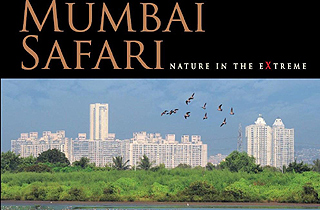In the rush of urbanisation, sometimes we forget that nature is bruised and exploited. The beautiful landscapes turn into a bustling city, landfill or sometimes just a barren piece of land. The book Mumbai Safari: Nature in the extreme by Sunjoy Monga—a conservationist, photographer, and naturalist, explores the incredible wealth of biodiversity across a range of habitats within and immediately around one of the world’s most congested urban regions, Mumbai, Maharashtra. In this book we get to see Mumbai and its surrounding areas as never seen before. It is literally a visual journey from the urban to back to the nature.
The book opens with some drawings and words from concerned citizens—the highlighted topics ranging from water wastage to more greenery to shelter for stray animals.
“Development, residential and commercial, replaces Mumbai’s open spaces with splotches of grey”—speak volumes of when we look for nature and not find it. From the collapsing hills to the crumbling coasts, this book documents it all and takes us far from the depressing aspect of development to the refreshing bounty of Mumbai and its surrounding areas’ flora and fauna which not many of us know.
The book includes the five Protected Areas—Sanjay Gandhi National Park (SGNP), Tungareshwar Wildlife Sanctuary (TWLS), Tansa Wildlife Sanctuary, Karnala Bird Sanctuary and Phansad Wildlife Sanctuary, the middle and upper reaches of Matheran range, sites of Shayadri Hills, Khargarh-Parsik Hills, Alibaug Hills and forests of Raigad and Thane. Not many of us would know that out of 22 hills across the seven islands of the erstwhile Bombay, many were razed for materials to fill in the low-lying areas connecting the islands. Out of the few remaining ones, couple of them are now amongst the country’s priciest real estate.
The rich flora and fauna of the region is shown thriving under the monsoon showers and also shown along with it is the effective conservation actions taken up during recent times to ensure the survival of the natural habitat. The book is also an excellent guide for the nature lovers as it is filled with information about when and what-to-do in the region before, during and after monsoon. The Western Ghats, one of the world’s biodiversity hotspots, is shown with its bountiful flora, Thane Creek and the coastal areas—a hotspot for bird-watching, Shayadri Hills—the haven for amphibians, to name a few.The creepy crawlies also finds a place in this book.
The book is not only about the flora and fauna, its vanishing act and the need to revive it but also about the vanishing old cultures and traditions of the native inhabitants of the regions. The fact that these native traditions are fast fading to oblivion is a matter of great concern because the natives are the ones who have a general knowledge of the region’s plant and animal life and can give us a great lesson in conservation. The Mumbai Safari is, very aptly, a visit to Nature in the extreme and a must-read. Last but not least, the book comes with a small booklet of trails guide and key fauna checklists.
USV Limited, under its CSR programme, has initiatives for the environment and women empowerment. As part of its environment protection programme, the company, under the ‘Flora and Fauna’ initiative, has sponsored the book by Sunjay Monga, titled ‘Mumbai Safari – Nature in the extreme‘.




